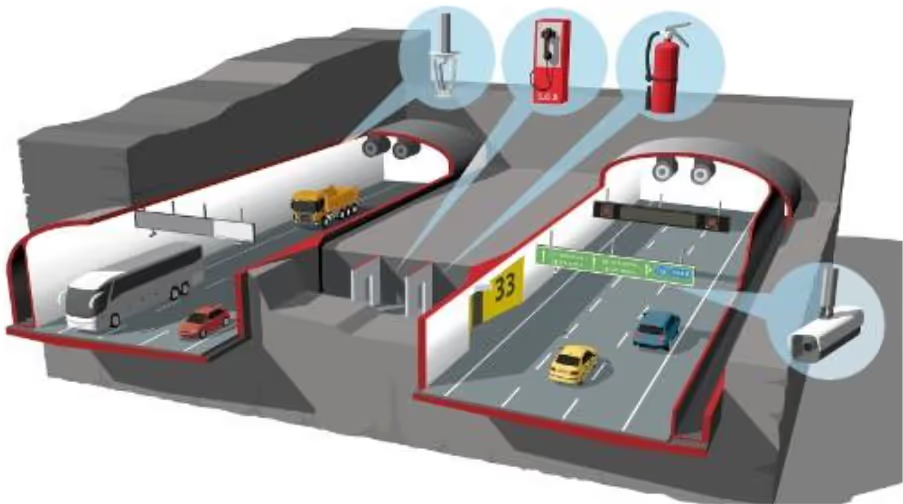

Transitioning our transportation systems to use renewable sources of energy is a key element of reaching emission reduction goals and climate targets. In road transport, low and zero emission vehicles (LZEVs) are playing a key role, in particular electric vehicles (EVs). EVs are anticipated to replace conventional internal combustion engine vehicles (ICEVs) powered by fossil fuels in many applications such as passenger cars, buses and trucks. EVs are predominantly battery-electric vehicles (BEVs), which this article focuses on, but other types of EVs, such as fuel-cell electric vehicles (FCEVs) powered by hydrogen, exist as well.
A concern regarding EVs is the potential safety of their energy storage systems, i.e. their high-voltage battery, which has different characteristics than the fuel tank of an ICEV. This includes battery fire safety, high-voltage systems, new materials and their chemical properties, as well as environmental impacts. These differences need to be understood and considered for our transport infrastructure, which may not be ready, or not optimised, to accommodate large numbers of EVs.
This paper looks at the potential risks and challenges associated with operating EVs in tunnels, a crucial part of our road infrastructure, as EV fires are a potential concern for tunnel safety. This includes tunnel design and structure, as well as tunnel operations in case of an emergency.
The findings presented in this paper are based on a broad review of relevant scientific studies, reports, data bases, case studies and other literature sources. In addition, consultations were conducted with industry experts in tunnel operations and EV battery fire safety.
Firstly, vehicle fire and incident statistics show that EVs are far less likely to catch fire than ICEVs (Bodine at al. 2022, EV Fire Safe 2024). However, characteristics of EV fires differ from ICEV fires and need to be understood to appropriately manage their risks.
EV fire causes can be structured broadly into 3 categories: mechanical, electrical and thermal abuses (refer to Figure 1). All of these causes can eventually lead to a situation where the battery develops internal short circuits, causing the battery to enter a ‘thermal runaway’ whereby excessive heat is generated that cannot be controlled by battery cooling mechanisms. Such a situation can result in battery overheating and damage (Wang et al. 2019). The consequence can be an EV fire.

Mechanical damage to the battery, which can be caused by the involvement of EVs in crashes, has been the most common cause of battery damage leading to fire incidents. About half of all EV fires where the cause has been identified can be traced back to mechanical abuses (Tesla Fires 2024). This is an important consideration for tunnel operations, where crashes can occur. In contrast, electrical abuses, the secondmost frequent cause of EV battery fires, are unlikely to occur in tunnels on their own (unless triggered by a mechanical abuse), as EVs are typically not charged inside tunnels.
The key technical considerations in relation to EV fires include the heat release rate (HRR) from EV fires compared to ICEV fires; the impact of the state of charge (SoC) of the EV battery on the fire; pollutant emissions linked to EV fires; and EV fire behaviour.
Differences exist in the peak HRR and the total amount of energy released, depending on the fire scenario and vehicle model, including factors such as battery type, battery size and energy content, vehicle characteristics, how the battery was damaged and how soon it entered thermal runaway. However, the peak HRRs of EV and ICEV fires are broadly comparable (Hynynen et al. 2023). Regarding the SoC, batteries with a higher SoC have a higher peak HRR than batteries with a lower SoC (Larsson at al. 2014). This means that EVs with fully charged batteries, if damaged, pose a greater fire risk.
Vehicle fires generally produce a range of toxic or polluting substances. It was found that EV fires do not cause significantly more pollutants or toxic gases than ICEV fires. An exception is hydrogen fluoride (HF). The amount of toxic HF released from a BEV fire was found to be more than 50 times higher than that from an ICEV fire per mass of vehicle (Willstrand et al. 2020). Sprinkler systems help to lower the HF concentrations. Finally, EV battery fires usually originate underneath the vehicle chassis, where the battery is usually installed. This means that the fire can spread in a different way compared to and ICEV with a fuel tank.
This section outlines the findings of the study regarding managing the risk of EV fires in tunnels. It first provides an overview of Australian tunnel design and operations as a basis for understanding the effect and consequences of EV fires on the tunnel design and operations (O’Connor et al. 2023). Then, a potential solution for managing EV fire risks in tunnels is presented.
Figure 2 depicts the fire safety equipment generally present within a road tunnel. The tunnel lining is made from concrete and is covered by wall panels, or cladding made from fire-rated materials such as calcium silicate instead of panels, and a fireproof spray finish can be applied to the tunnel lining. Asphalt road pavement is usually used in major tunnels in Australia and New Zealand, with more tunnels located in or near urban areas. Jet fans and ducts are present to provide ventilation and extract smoke and exhaust fumes from the tunnel. Deluge systems are installed in the tunnel ceiling for fire safety. When activated, they can release large volumes of water rapidly to suppress the fire. Evacuation facilities such as cross passages, emergency exits and emergency telephones are also present in tunnels. Tunnels are usually equipped with fire extinguishers and closed-circuit television provides operators with a real-time view of the inside of the tunnel.

Within the context of fire safety, tunnel design considers the materials used in the tunnel structure, the presence of deluge systems, the type of ventilation installed and the evacuation facilities. The design takes into consideration vehicle types and (expected) traffic volumes in the tunnel (Technical Committee 3.3 Road Tunnel Operation 2017). The 3 key design objectives are tunnel evacuation, firefighting and asset protection. Australian and New Zealand tunnels adopt a performance-based approach, in response to a selected design fire (Technical Committee 3.3 Road Tunnel Operation 2017) that can be expressed as a fire size measured by the HRR.
Tunnel operation ensures safe and efficient traffic flow throughout the tunnel (Bergeson & Ernst 2015). Tunnel operators monitor and manage traffic flow, perform tunnel maintenance and assist with incident response and management. An emergency response plan is tailored for each tunnel due to their individual operational characteristics. A maintenance schedule involves fire agencies and tunnel operators and ensures that the tunnel and its deluge, ventilation and other systems, function as intended (AFAC 2018).
The type of the traffic flow is important for the design of fire safety within the tunnel. Bidirectional tunnels have been found to have 40% higher rates of accidents (Egger 2001), which increases the fire risk as a result of accidents. Unidirectional tunnels have separate tubes for each direction so evacuees can be directed to the other tube in case of a fire.
Traffic volumes also affect the likelihood of a fire occurring within the tunnel. For ICEVs, the frequency of fires in major Australian road tunnels is estimated to be 8 fires per billion vehicle kilometres travelled (Austroads 2019).
Safety protocols ensure that tunnel users are driving safely in the tunnel. This includes speed limits, keeping safe distances, avoiding sudden breaking and lane changes (Queensland Department of Transport and Main Roads 2023), as well as tunnel access restrictions for dangerous goods vehicles.
Considering the details outlined above about EV fires and tunnel design and operations, it is found that neither the HRR nor pollutant emissions from a single EV fire are likely to exceed Australian tunnel specifications. Concentrations of pollutants and toxic substances are expected to remain within the current specified limits, and single EV fires are unlikely to pose a concern for tunnel safety procedures or tunnel structures.
However, there is a risk of reignition of EV fires and they tend to take a long time to extinguish, requiring large amounts of cooling medium (usually water). This can pose a challenge for tunnel deluge systems that may not be designed to operate for extended periods of time. There is also a lack of clear guidance about how to remove an EV (that is at risk of reignition) from the tunnel. Concerns exist regarding future scenarios where heavy EVs (trucks or buses) that are hard to move, or large numbers of EVs, are involved in a fire simultaneously, resulting in a greater fire intensity that causes infrastructure damage.
Potential solutions include prohibiting or restricting certain vehicles such a heavy EVs (buses, trucks) from driving through tunnels. This lowers the probability of an incident involving heavy EVs and thus a larger battery fire. Regarding firefighting solutions, different approaches have been discussed and researched, including special equipment such as a firefighting lance (Sturm et al. 2022); letting the vehicle burn out to avoid reignition of the battery (AFAC 2022); and using large amounts of cooling water over an extended period of time to control the battery fire (Mellert & Welte 2020).
This paper summarises key findings about managing EV fires for tunnel operations. While EVs have different fire characteristics compared to conventional ICEVs, they generally do not pose a greater risk for tunnels than ICEVs. However, some questions remain unanswered, such as those around managing incidents involving heavy EVs.
In addition to EVs in tunnels, there are other potential risks and concerns for an EV future. This includes enclosed or underground car parks, where EV fires can pose a risk to buildings and their occupants, with some authorities taking questionable steps such as banning fully charged EVs from underground car parks (Hickey 2024). Heavy EVs can also exceed current (axle) mass limits due to their heavy traction battery and thus cause greater damage to roads than their conventional counterparts.
Consequently, these different issues need to be identified and solutions researched and implemented. This includes technical solutions for vehicles and infrastructure, as well as supporting guidelines and regulations for management and operations of our transport systems. As Australia and New Zealand are still at the beginning of the transition to an EV-dominated road transport system, we have the advantage to be able to learn from those who are further ahead on the transition curve, as well as from statistics and existing research.